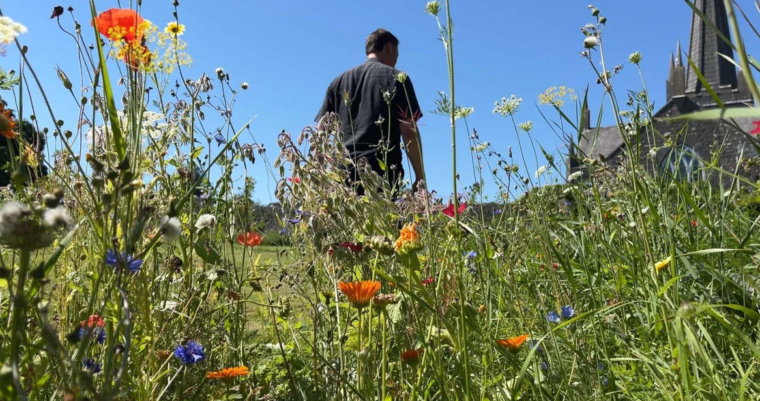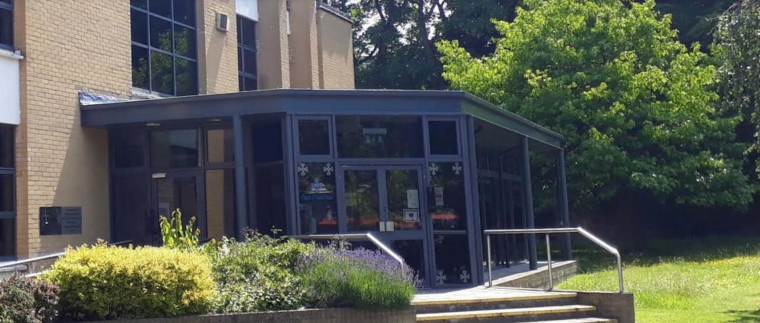Creating a school garden
A group of parishes in the border area of Clogher Diocese has been busy creating a garden and prayer resource for local schoolchildren. The project at Belleek Primary School is to create an outdoor learning space and prayer garden where children can grow their own vegetables and flowers and also have reflective prayer space. Many of the younger children from Garrison, Belleek, Slavin and Kiltyclogher attend the primary school and their rector, the Revd Rebecca Guildea, is a member of the Board of Governors.
To help fund the project, Rebecca ran the equivalent distance from her rectory to the school (four miles) some 40 times last autumn with a target of raising £500. However, her efforts were so successful that she raised more than double her target figure! She also received a grant from the Board of Education (Northern Ireland). Now the new garden is being transformed from a rundown activity area by volunteers, with the installation of raised beds to grow sensory plants, a pond and seating area and a wildflower garden for the children to enjoy.

New life for Belfast site
Glencairn Community Garden, at the foot of the Belfast Hills, is full of colour and life on an acre of what was previously derelict land beside St Andrew’s Parish Church.
Stephen Whitten from the North Belfast Centre of Mission and a core team of volunteers have been busy planting, painting, building, harvesting and more. The garden is bursting with vegetables as well as flowers, trees and an abundance of wild grasses and wildflowers.

Innovative heating in Sligo
Drumcliffe Church, in Co. Sligo, is currently heated with an air-to-water heat pump and is likely to be one of few churches in Ireland using a heat pump as a heating source. Looking upwards, the parish is keen to explore installing solar panels on the roof and use this to heat the underfloor electric heating system.
As part of National Biodiversity Week, the children of the Glebe National School, Aughrim, Co. Galway, recently conducted a wildflower survey in the Aughrim Climate Action Park and in the Rectory Garden Project.
The results were staggering. Thanks to the gradual processes of re-wilding, there is now an extravagant range of wildlife flourishing in the meadows and walled gardens. From daisies and dandelions to forget-me-nots to gentian speedwell; from clover and brambles to yellow rattle and yellow iris; from cuckoo flowers and cow parsley to purple vetch and phacelia, there is beauty beyond imagining, to delight the hearts of those who are eagle-eyed enough to seek it out.

Wildflowers abounding in Aughrim
As part of National Biodiversity Week, the children of the Glebe National School, Aughrim, Co. Galway, recently conducted a wildflower survey in the Aughrim Climate Action Park and in the Rectory Garden Project.
The results were staggering. Thanks to the gradual processes of re-wilding, there is now an extravagant range of wildlife flourishing in the meadows and walled gardens. From daisies and dandelions to forget-me-nots to gentian speedwell; from clover and brambles to yellow rattle and yellow iris; from cuckoo flowers and cow parsley to purple vetch and phacelia, there is beauty beyond imagining, to delight the hearts of those who are eagle-eyed enough to seek it out.

A thriving garden in Co. Down
With the help of a Queen’s Platinum Jubilee Award, Magheralin, outside Lurgan, Co. Down, has created a beautiful garden in its church grounds. The Garden of Reflection, which was officially opened last November, is a space to be shared and enjoyed by pollinators and people alike. It’s a place for the whole community, a place of beauty to be still and enjoy Creation.

Forest puts down roots
Among the news Bishop Paul Colton brought back from the Lambeth Conference was that of the inauguration of the Anglican Communion Forest. On behalf of all being confirmed in 2023 in Cork, Cloyne and Ross, Bishop Colton reached out to the Irish voluntary group Reforest Nation and arranged that Reforest Nation will plant an entire forest of 300 trees in their name. Each person being confirmed in the diocese this year has received a specially created certificate which combines the certificate of Reforest Nation with the artwork of the Anglican Communion Forest adapted, with permission, for use in the diocese.

Church trustees prioritise environment
The Church of Ireland’s Environmental Charter, approved by General Synod in 2015, asks all members to play their part in the stewardship of Creation, by recognising and reducing waste, increasing their awareness of environmental issues, exercising leadership, identifying with the developing world, and seeking to influence policy.
To help fulfil its commitment, the Representative Body – the Church’s central trustee body, has set out four main areas where it expects to make the greatest difference in improving environmental sustainability. Firstly, the RB will reduce energy usage in light and heat through insulation and installing LED lighting, and encouraging the use of sustainable energy. Likewise, in transportation, there will be a focus on reducing distances travelled and encouraging more energy-efficient forms of transport. Waste will be minimised and, where it occurs, disposed of in ways which limit its impact on ecosystems. There will also be a focus on preserving both the variety and numbers of flora and fauna, as is already happening through the beehives in the grounds of Church House, in Rathmines.

These priorities, through the current Climate Change Policy, will be accompanied with guidance in Parish Resources on the Church of Ireland’s website. Central church committees will seek to encourage a biodiverse and low energy environment through grants issued to parishes and dioceses. For example, €100,000 has been allocated from the Church Fabric and Development Fund for a Properties Energy Efficiency Grants programme for church buildings, which will be opened up in the coming year.
